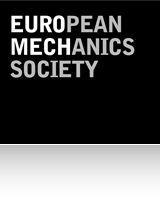600 – New challenges in finite element technology – from the perspective of mechanics and mathematics
Chairperson:
Prof. Stefanie Reese
RWTH Aachen University
Institute of Applied Mechanics
Mies-van-der-Rohe-Str. 1
D-52074 Aachen
Germany
Co-chairperson
Prof. Peter Hansbo
Jönköping University
Department of Mechanical Engineering
SE-55111 Jönköping
Sweden
The standard finite element method (FEM) is a well established numerical spatial discretization method which – also by means of commercial software packages – has found its way into universities, research institutions and industry. The range of applications for numerical simulation is steadily growing which poses new challenges, in particular with respect to non-linear finite element technology.
One issue is the need to simulate damage and failure, with the final goal to estimate lifetime of a structure. In many cases, damage processes are accompanied by a noticeable amount of plastic deformation. Close to failure, large deformations may be reached. Currently available finite element formulations lack stability and robustness, especially when the deformation localizes. The separation of material is difficult to model, in particular if – as it is standard for continuous Galerkin formulations – continuity in the displacement field is assumed. At this point, the use of discontinuous Galerkin methods, extended FEM or combinations of these might provide an improvement.
Another topic are heterogeneous microstructures as they frequently occur in composites or biological materials. Highly complex geometries have to be meshed which is usually very difficult to be achieved by hexahedral formulations. Tetrahedral formulations or isogeometric analysis might be a better choice. For these methods, issues such as robustness and stability are not yet sufficiently explored, in particular when large deformations and large material contrasts come into play.
Before the main topics of the colloquium are summarized below, it should be emphasized that it is often necessary – especially if a mathematical analysis is strived for – to concentrate on only one source of non-linearity. This could be e.g. the incorporation of large strains, small strain elasto-plasticity, small strain elastic damage or the presence of large material contrasts.
One main idea of the colloquium is to generate a beneficial exchange between current knowledge in mechanics and mathematics. The organizers understand this as a crucial prerequisite to reach the far goal of the field: a robust and stable non-linear finite element technology which can be suitably adapted to the special needs of the non-linear modeling of interest.
For this reason it is planned to have for each topic area about the same number of speakers from mathematics and mechanics. The discussion time for each talk will be unusually long, for 30 min talk about 15 min. Alternatively, each speaker is given the opportunity to choose an interactive format for his/her talk. Additionally, a “round table” discussion is planned after each topic area.
Each contribution should contain at least one of the previously mentioned sources of non-linearity.
Topic area 1: Discontinuous and nonconforming finite element formulations
Topic area 2: Continuous Galerkin formulations based on multi-field variational principles
Topic area 3: Extended FEM
Topic area 4: Tetrahedral FEM for large material contrast and large localized strain
Topic area 5: Isogeometric analysis
